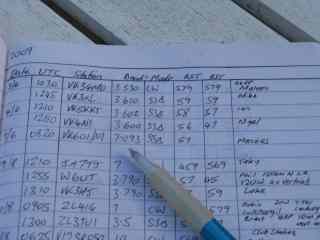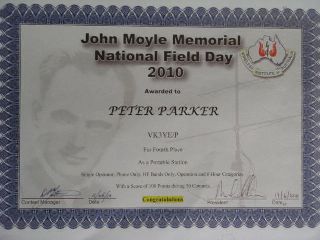

Return to VK3YE beginner and general articles
|
An HF Primer (Part 2)
  Part One covered basic HF operating procedure. Part Two takes a more detailed look at specific operating activities enjoyed by amateurs. DXing
In amateur parlance, DX means long distance, normally defined by HF operators as being outside one's continent. There are many amateurs who, after establishing a station, enjoy talking around the world. DX operators have a variety of motives; some like experimenting with antennas, while others prefer to chase various operating awards.
As well as having an efficient station, good operating skills are important for the successful DX-er. These include a knowledge of radio propagation, being able to discern weak signals, a habit of listening around the band before transmitting, and a sense of timing when calling another station. Clear pronunciation, the use of standard phonetics on SSB, and steady sending on Morse are the hallmarks of the good operator.
Active DXers place great importance on contacting remote, obscure islands. Sometimes, groups of DXers may organise special voyages (called DXpeditions) to such islands, so that other amateurs may work them. These DX peditions are very costly, and organisers often solicit donations from amateurs and commercial sponsors.
When a signal from a DX-pedition is heard, there are often many stations trying to make contact. Quite appropriately, this wall of QRM is called a 'dogpile'. DXpedition stations may operate 'split-frequency'. This means that you listen on one frequency and transmit on another. For this reason, serious DXers use transceivers with dual VFOs.
Being able to be heard by a DX station is a matter of strategy and timing; the station might have a particular pattern of operating that you can exploit. When called by a DX station, make the contact brief, as you would in a contest, as many others may be waiting for their turn.
The impression gained so far is that the DXer is a rather competitive, solitary operator. This is not always so; some DXers hunt in packs. Several nets for amateurs who enjoy working DX, exist on the bands. In addition, DXers have set up spotter websites that alert users when a distant or rare station appears on the band. However this relies on someone being there to tune around and listen and it might as well be you.
Contests
A contest is an organised event where the aim is to make the most number of contacts within a given period. Apart from being an exciting and absorbing activity in its own right, contesting allows you to test the efficiency of your station, together with operating skills. With there being many stations on the air at the one time, a contest is an ideal opportunity to have contacts with various countries or call areas so that you can work towards many of the awards on offer.
While most major contests run for 24 hours, some short contests ('sprints' or 'scrambles') run for only an hour or two. These short contests have simple rules, and are good fun.
Contest contacts are much shorter than most other amateur radio contacts; all you need to exchange with the other station is a five or six digit number, consisting of a signal report followed by a serial number starting at 001. This serial number increases by one for every contact you make, thus you might send 57003 to the third station you work in a contest. The object is to make as many contacts as possible within the contest period.
The following is a typical example of an SSB contest exchange between VK1AA and VK6AA.
(VK1AA): CQ CQ CQ RD CONTEST, THIS IS VK1AA.
(VK6AA): VK6AA
(VK1AA): VK6AA, THIS IS VK1AA. My NUMBER TO YOU IS 57011
(VK6AA): THANK YOU FOR THE 57011. MY NUMBER TO YOU IS 58001
(VK1AA): 58001 RECEIVED. 73 AND GOOD LUCK IN THE CONTEST.
On CW, the procedure is similar, except there is a heavy use of abbreviations to save time (see Part One). Very often, nines are sent as 'N', and zeroes as 'T'. Thus, the first station you work might receive a '5NNTT1' number from you, which is the equivalent of a 59001 report on phone.
To formally enter a contest, a log of all contacts must be emailed or posted. A sample log sheet, suitable for most contests, is shown in Figure 1. Normally, a front summary sheet, which shows your name, callsign, total score and declaration that you operated ethically is stapled to the front of the log - the format for this is generally specified in the contest rules.
The major WIA-sponsored Australian contests are as follows:-
* Remembrance Day Contest (August)
In addition to the above are smaller contests run by local clubs or special interest groups. These are often confined to one or two bands and may be for a few hours only. Certificates are awarded to contest placegetters. Contest rules and results can be found at www.wia.org.au.
FIGURE 1 - SAMPLE CONTEST LOG SHEET
Name--------------Callsign-------------Contest---------------------
Date----UTC----Band---Mode---Callsign------RST/no. sent----RST/no. rec--------Points
______________________________________________________________________
This log sheet is typical only, but should be acceptable for most contests. Read the rules applicable to the particular contest for more information.
Awards
An award is a certificate received for having contacted a specified number of stations in a certain geographic area, or on a particular mode. They range from the local club award to the internationally-recognised, and from the easy to the almost impossible.
The most well-known international award is the DXCC (DX Century Club), issued to those amateurs who have proved that they have contacted at least 100 countries. Another award gaining prominence is the 'Islands of The Air' (IOTA) award for contacting a specified number of islands.
The WIA has its own awards program, with certificates issued free to members. Its awards include:-
* WIA DXCC
Refer to the WIA website for further information on the above awards. Those interested in collecting awards should maintain a log of stations worked. Note that verification of contacts, for instance through QSL cards, is required to show proof of having worked a station; log entries alone are not sufficient. In some cases various forms of electronic QSLing may be accepted; read award conditions carefully.
The sound of local and international HF contests (note the different amount of crowding)
QSLing
A long-standing tradition has been to exchange QSL cards after the completion of a contact. The practice comes from the days when working DX (usually with low power and home made equipment) was much more of an achievement than it is today. Many overseas stations tend to be almost obsessed with QSLing, to the point that they ask for a card even if filling in and sending the card takes longer than the original two-minute contact. In contrast, many VKs are more laid back, only sending cards for the more memorable contacts. It may be for this reason that we have the reputation of being bad QSLers.
Nevertheless, QSLing is almost mandatory for those who aspire to collect awards, which normally require cards to show evidence of contacts claimed. Also, the new amateur will often want to decorate the shack with cards received from distant countries. After a wall has been 'wallpapered', the novelty often wears off, with many an amateur storing cards in shoe boxes in a seldom-opened cupboard.
Active HF amateurs always keep a stack of their own QSL cards, even if they were only sent infrequently for prized contacts. Cards should be of postcard size, and include your callsign, address and (preferably) your Maidenhead grid square locator number. It should include spaces for the callsign worked, UTC date and time, signal report, band, and mode used. Spaces on the card for your equipment, antenna and power output are also desirable.
There are two ways of sending cards. They may be posted via the normal mail system. While fast, it is expensive. Fortunately, the WIA and its sister societies have established QSL bureaus for use by members. These bureaus send and receive QSL cards in bulk, so postage costs are reduced. Though sending cards 'via the bureau' is slower than QSLing 'direct', the money saved is considerable, particularly if you are an avid DXer.
QSL Bureaus consist of two sections; Inwards and Outwards. The Inwards section receives cards from overseas and interstate, and distributes them to members, while Outwards accepts cards from you and forwards them to bureaus in other states/countries. Further information on the WIA website.
An increasing number of amateurs are not bothering with paper QSL cards. Instead they use eQSL or ARRL's Logbook of the World. As mentioned before it's worth checking the QSL policies of any awards you wish to claim before deciding on how you'll QSL.
QRP
QRP operation is the use of low transmit powers. Its adherents gain a special pleasure from working across the country or across the world with a couple watts of power. QRP, defined as the use of five watts or less on CW, and ten or less on SSB, is ideal for portable operation, where lightweight transmitting equipment must be used. In other words all Foundation licensees are automatically QRPers, at least on SSB. In addition, the low-cost and simplicity of QRP equipment makes building one's own transceiver a practical proposition, particularly for CW operation.
Practically the full range of operating activities, such as DXing, contesting and VHF operation can be done with QRP. An efficient antenna and good operating skills are required for maximum success. Ownership of special equipment is not required; QRP can be obtained from many 100 watt transceivers that can be turned down to 5 or 10 watts output.
QRP in Australia is promoted by the VK QRP Club, which publishes a quarterly magazine and sponsors contests for QRP operators. More information on QRP also appears on this site here.
Example contacts with QRP stations
Further information
Operating technique contains many subtleties and even experienced amateurs are still learning. If there's points you aren't
quite clear on there's additional information in
First Contacts on Amateur Radio and An HF Primer.
Even more detail on operating is provided in these favourably reviewed books.
Items were chosen for likely usefulness and a satisfaction rating of 4/5 or better.
Conclusion
These articles have, I hope, given you a better knowledge of HF operation. As well as reading about it, the best way to learn is by listening and operating yourself. Extensive further information is contained on this and other websites.
|
Books by VK3YE
Ham Radio Get Started (USA)Australian Ham Radio Handbook (Aust) More Hand-carried QRP Antennas 99 things you can do with Amateur Radio Getting back into Amateur Radio Illustrated International Ham Radio Dictionary Make your Passion Pay (ebook writing)
All material on this site |